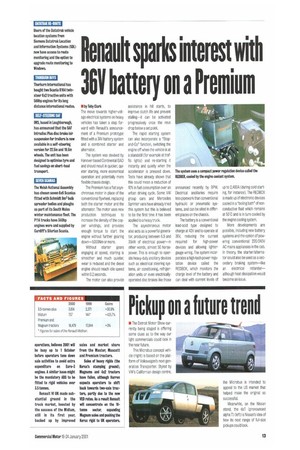Renault sparks interest with
Page 15

If you've noticed an error in this article please click here to report it so we can fix it.
36V battery on a Premi UM
• by Toby Clark The move towards higher-voltage electrical systems on heavy vehicles has taken a step forward with Renault's announcement of a Premium prototype fitted with a 36V battery system and a combined starter and alternator.
The system was devised by Hanover-based Continental ISAD and should result in quicker, quieter starting, more economical operation and potentially more flexible chassis design.
The Premium has a flat asynchronous motor in place of the conventional flywheel, replacing both the starter motor and the alternator. The motor uses new production techniques to increase the density of the copper windings, and provides enough torque to start the engine without further gearing down-1,000Nm or more.
Without starter gears engaging at speed, starting is smoother and much quieter, wear is reduced and the diesel engine should reach idle speed within 0.2 seconds.
The motor can also provide assistance in hill starts, to improve clutch life and prevent stalling—it can be activated progressively once the revs drop below a set point.
The rapid starting system can also incorporate a "Stopand-Go" function, switching the engine off when the vehicle is at a standstill (for example at traffic lights) and re-starting it instantly and quietly when the accelerator is pressed down. Tests have already shown that this could mean a reduction of 10% in fuel consumption over an urban driving cycle. Some VW group cars and Mercedes Sprinter vans have already tried this system but this is believed to be the first time ft has been applied to a heavy truck.
The asynchronous motor also acts as a powerful generator, producing between 6.5 and 35kW of electrical power—in other words, almost 50 horsepower. This is enough to operate heavy-duty ancillary devices such as electrical steering systems, air conditioning, refrigeration units or even electricallyoperated disc brakes like those
announced recently by BPW. Electrical ancillaries require less ptpework than conventional hydraulic or pneumatic systems, and can be sited in different places on the chassis.
The battery is a conventional lead-acid type designed to charge at 42V and to operate at 36V, reducing the current
required for high-power devices and allowing lightergauge Wring. The system incorporates a high-tech power regulation device called the REDBOX, which monitors the charge level of the battery and can deal with current levels of up to 2,400A (during cold starting, for instance). The REDBOX Is made up of electronic devices cooled in a "boiling bath of nonconductive fluid which remains at 50'C and is in turn cooled by the engine cooling system.
More developments are possible, including new battery systems and the option of powering conventional 220/240V AC mains appliances in the cab. In theory, the starter/alternator could also be used as a secondary braking system—like an electrical retarder— although neat dissipation would become an issue.
































































































